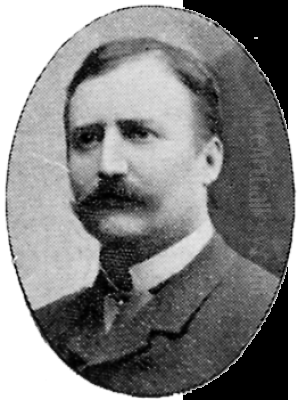
Wilhelm von Gegerfelt stands as a significant figure in the landscape of late 19th and early 20th-century Swedish art. A painter renowned for his evocative depictions of diverse European settings, from the shimmering canals of Venice to the rugged coastlines of his native Sweden and the chalk cliffs of England, Gegerfelt carved a unique path through the evolving art movements of his time. Born into an era of artistic transition, he navigated the currents of Realism, the Düsseldorf School's precision, and the atmospheric allure of burgeoning Impressionism, ultimately forging a style celebrated for its sensitivity to light and mood. His life and work reflect a journey through key artistic centres and a deep engagement with the natural world, leaving behind a legacy preserved in major museum collections and appreciated for its lyrical beauty.
Early Life and Formative Artistic Education
Wilhelm von Gegerfelt was born on September 11, 1844, in Gothenburg, Sweden. His familial background provided an early connection to the world of design and aesthetics; his father was the notable architect Victor von Gegerfelt. This environment likely fostered an appreciation for structure and form, though young Wilhelm's path would lead him towards the painter's canvas rather than the architect's blueprint. His formal artistic training began not in Sweden, but in Denmark.
From 1861 to 1863, Gegerfelt studied at the prestigious Royal Danish Academy of Fine Arts in Copenhagen. This period placed him within an environment still echoing the Danish Golden Age, though new influences were beginning to emerge. Following his time in Copenhagen, he returned to his homeland to continue his studies at the Royal Swedish Academy of Fine Arts in Stockholm from 1864 to 1867. Stockholm's art scene was steeped in National Romanticism, often focusing on Swedish history and landscapes rendered with a degree of academic formality.
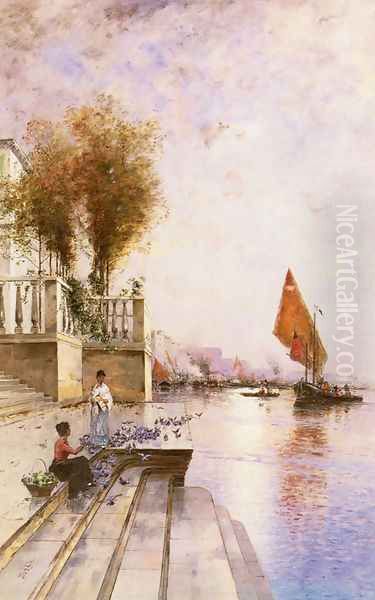
Seeking further refinement and exposure to different artistic traditions, Gegerfelt then travelled to Germany. He spent a significant period, from 1867 until 1872, studying in Düsseldorf. The Düsseldorf Academy was internationally renowned, particularly for its school of landscape painting, which emphasized detailed observation, dramatic compositions, and often a narrative or allegorical element. Artists like Andreas Achenbach and Oswald Achenbach were dominant figures associated with the school, known for their technically brilliant and often grandiose landscapes. While Gegerfelt absorbed the technical discipline associated with Düsseldorf, his artistic trajectory would soon take him towards different modes of expression.
The Parisian Influence and a Nordic Breakthrough
After his formative years in the academies of Scandinavia and Germany, Gegerfelt moved to Paris in 1872. This relocation marked a pivotal moment in his career. Paris was undeniably the epicentre of the art world, buzzing with new ideas and movements that challenged academic conventions. It was here that Gegerfelt encountered a more liberated approach to painting, particularly the growing emphasis on capturing fleeting moments and the effects of light and atmosphere, hallmarks of the Barbizon School and the nascent Impressionist movement.
In Paris, Gegerfelt formed a significant professional relationship with fellow Scandinavian artist Alfred Wahlberg. Together, they reportedly developed a new technique or approach to painting. While the specifics of this technique are not always detailed, it is generally understood to involve a looser brushstroke, a greater emphasis on tonal values, and a more direct, plein-air sensibility compared to the tighter rendering favoured in Düsseldorf. This collaboration and stylistic evolution positioned Gegerfelt as one of the figures contributing to the "modern breakthrough" in Nordic art – a movement away from strict academicism towards Realism and Impressionism-influenced styles.
The Parisian environment exposed Gegerfelt to a wide range of influences. He would have seen the works of Barbizon painters like Jean-Baptiste-Camille Corot and Charles-François Daubigny, admired for their atmospheric landscapes painted outdoors. He also arrived as Impressionism was taking shape, with artists like Claude Monet, Camille Pissarro, and Alfred Sisley pioneering revolutionary ways of depicting light and colour. While Gegerfelt never became a full-fledged Impressionist, the movement's focus on atmospheric effects and capturing the immediacy of a scene clearly resonated with his developing style. Other Scandinavian artists like Anders Zorn, Carl Larsson, and Bruno Liljefors were also part of the vibrant Nordic community in Paris during this era, contributing to a dynamic exchange of ideas.
Journeys Across Europe: Expanding the Canvas
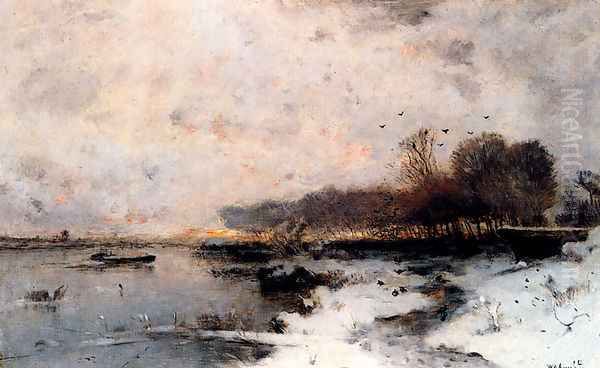
Gegerfelt's artistic curiosity was not confined to Paris. He embarked on extensive travels throughout Europe, seeking diverse landscapes that would become central themes in his oeuvre. His journeys took him to the sun-drenched canals of Venice, the dramatic coastlines of Northern France (likely Brittany or Normandy), the distinctive white chalk cliffs of England, and, of course, back to the familiar shores and countryside of Sweden.
Venice, in particular, became a recurring and beloved subject. Gegerfelt excelled at capturing the unique interplay of light, water, and architecture in the city. His Venetian scenes often focus on the reflections in the canals, the silhouettes of gondolas, and the atmospheric haze that can envelop the city, particularly during sunrise or sunset. These works move beyond mere topographical accuracy to evoke the romantic and sometimes melancholic mood of Venice. His approach can be seen as part of a long tradition of artists captivated by the city, from Canaletto in the 18th century to J.M.W. Turner's atmospheric interpretations and later depictions by contemporaries like Anders Zorn.
His paintings of the English coast captured a different kind of atmosphere – perhaps the misty air and the stark geological formations of the chalk cliffs. In France, artists like Eugène Boudin were known for their coastal scenes, and Gegerfelt's work in this area likely absorbed some of the plein-air techniques used to capture the changing light and weather along the shore. Throughout these travels, Gegerfelt honed his ability to adapt his technique and palette to the specific light and character of each location, demonstrating remarkable versatility as a landscape painter. His Swedish scenes, often depicting the coast (perhaps the Bohuslän region or Hallands Väderö), possess a distinct Nordic sensibility, capturing the quality of light and the rugged beauty of his homeland.
The Skagen Connection: A Nordic Artistic Colony
Beyond his time in Paris and his individual travels, Gegerfelt also became associated with one of the most important artistic phenomena in late 19th-century Scandinavia: the Skagen Painters. This loose collective of artists gathered during the summer months in Skagen, a remote fishing village at the northernmost tip of Denmark, drawn by the unique quality of light, the picturesque subjects, and the spirit of camaraderie.
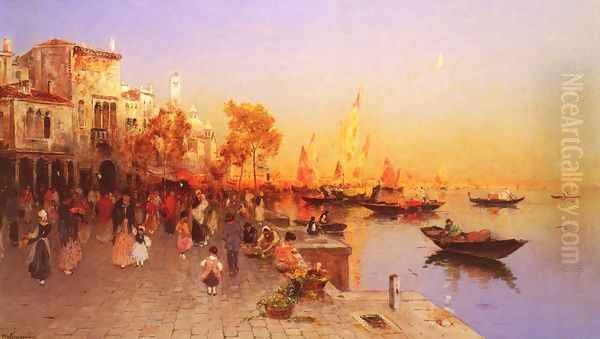
The Skagen Painters were primarily Danish, Norwegian, and Swedish artists who embraced Realism and plein-air painting, often influenced by French Impressionism. They sought to depict the local landscape, the lives of the fishermen, and the social gatherings of the artists themselves, all under Skagen's famously luminous sky. Gegerfelt was among the Swedish artists who frequented Skagen, interacting with key figures of the colony.
His contemporaries and associates there included prominent names from across Scandinavia. He interacted with the influential Danish critic and writer Georg Brandes, who championed realism and naturalism, and the poet and painter Holger Drachmann. Among the painters, he associated with the Norwegian Realist Christian Krohg, the Danish painter and later art historian Karl Madsen, and the skilled Danish marine painter Carl Locher. Other artists connected to the Skagen scene during various periods included the German painters Fritz Stoltenberg and Julius Runge, the British painter Adrian Stokes, the Norwegian Impressionist Frits Thaulow, and fellow Swede Charles Lundgren. While perhaps not as central to the colony as figures like P.S. Krøyer or Michael Ancher, Gegerfelt's presence and participation underscore his integration within the progressive currents of Nordic art during this period. His involvement reflects the shared interest among these artists in capturing modern life and landscape with truthfulness and atmospheric sensitivity.
Signature Themes and Artistic Style
Wilhelm von Gegerfelt's body of work is primarily defined by landscape painting, showcasing a remarkable ability to capture the essence of different environments. His most characteristic subjects include the aforementioned Venetian canals, coastal scenes from Sweden, England, and France, tranquil river landscapes often depicted at sunset or twilight, and bustling Italian harbours. Water, in its various forms – canals, rivers, the sea – is a near-constant presence, allowing Gegerfelt to explore the complexities of reflection, light, and transparency.
His style evolved throughout his career, moving from the more detailed approach likely influenced by his Düsseldorf training towards a looser, more atmospheric manner developed during and after his time in Paris. While clearly aware of Impressionism and incorporating its lessons about light and colour, he generally maintained a stronger sense of structure and form than the core French Impressionists. His work often balances realistic observation with a poetic sensibility, imbuing his landscapes with a distinct mood, whether it be the vibrancy of a sunny Venetian afternoon or the quiet melancholy of a Nordic winter sunset.
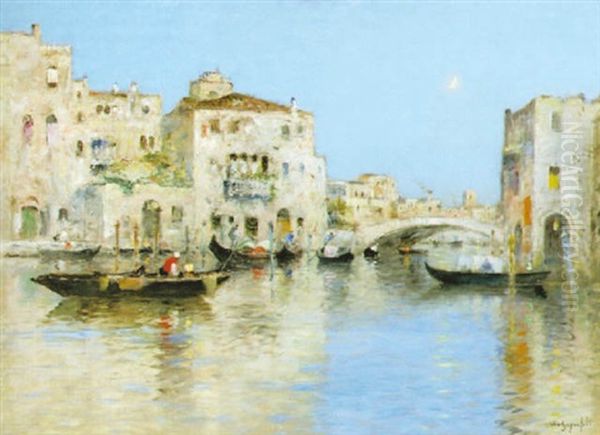
Key representative works often cited include titles like A Venetian Canal, A Winter River Landscape at Sunset, and An Italian Port. Other known titles further illustrate his thematic range, such as Strandparti från Hallands Väderö (Beach Scene from Hallands Väderö), Canal Grande, Venedig (Grand Canal, Venice), and Aftonstämning, Venedig (Evening Mood, Venice). His brushwork became increasingly free, allowing him to suggest form and texture rather than delineating every detail. He demonstrated a masterful handling of tonal values, creating convincing illusions of depth and atmosphere. His palette could range from subtle harmonies in misty coastal scenes to more vibrant contrasts in depictions of sunsets or brightly lit Italian settings.
Exhibitions, Recognition, and the Art Market
An artist's reputation is built not only on the quality of their work but also on its visibility through exhibitions and its reception by critics and collectors. Wilhelm von Gegerfelt achieved considerable recognition during his lifetime, exhibiting his work both within Scandinavia and internationally. His participation in exhibitions was crucial for establishing his name and attracting patrons.
Sources indicate he exhibited in Monaco, possibly as early as 1883. He achieved notable success at the Vienna International Exhibition in 1883, where he was awarded a silver medal, a significant honour confirming his standing on the European stage. His presence in major international exhibitions demonstrated his ambition and the appeal of his work beyond Nordic borders.
Furthermore, Gegerfelt found success in the competitive Parisian art market. He sold works through galleries in the French capital, indicating that his style resonated with contemporary tastes. His connection with the prominent art dealership Goupil & Cie is particularly noteworthy. Goupil & Cie was a major international firm that handled works by many leading artists of the time, and their association with Gegerfelt speaks to his commercial viability and the perceived quality of his paintings. He also attracted high-profile collectors, including the Duke of Bassano in France, further cementing his reputation. This success in the market provided him with the means to continue his travels and artistic production.
Later Years in Torekullen and Enduring Legacy
After years of travel and immersion in the international art scenes of Düsseldorf, Paris, and Skagen, Wilhelm von Gegerfelt eventually returned to Sweden for his later years. He chose to settle in Torekullen, located in the scenic Kulla Peninsula (Kullahalvön) in Skåne, Southern Sweden. This area, known for its natural beauty and dramatic coastline, provided ample inspiration for his continued landscape painting. His decision to settle here suggests a desire for a quieter life, perhaps, and a renewed focus on the landscapes of his homeland.
He continued to paint until his death on April 2, 1920, in Torekov, near Torekullen. His later works likely continued to explore the effects of light and atmosphere on the Swedish landscape, informed by decades of experience painting diverse European settings.
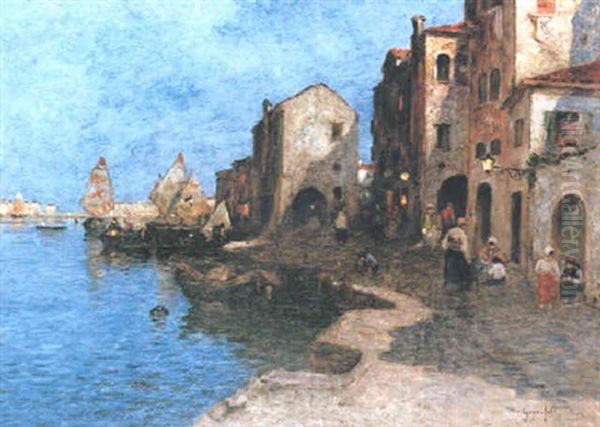
Wilhelm von Gegerfelt's legacy resides in his significant contribution to Swedish and Nordic landscape painting during a period of profound artistic change. He successfully navigated the transition from academic traditions towards a more modern, atmospheric realism, influenced by but distinct from French Impressionism. His ability to capture the specific mood and light of varied locations – the shimmering humidity of Venice, the crisp air of the Nordic coast, the gentle light of a setting sun – remains a hallmark of his work.
His paintings are held in the collections of major institutions, including the Nationalmuseum in Stockholm, the Gothenburg Museum of Art (Göteborgs Konstmuseum), and the Skagens Museum in Denmark, ensuring their accessibility to future generations. He is remembered as a skilled and sensitive interpreter of landscape, a key participant in the vibrant artistic exchanges of his time, particularly through his connections in Paris and Skagen, and an important figure in the development of modern art in Sweden.
Conclusion: A Master of Light and Place
Wilhelm von Gegerfelt occupies a respected place in the history of Scandinavian art. As a painter deeply attuned to the nuances of light and atmosphere, he translated the diverse landscapes of Europe onto his canvases with skill and sensitivity. From his rigorous academic training to his engagement with the progressive art scenes of Paris and Skagen, his career reflects a journey of continuous artistic exploration. His depictions of Venetian canals, European coastlines, and Swedish vistas stand as testaments to his mastery of landscape painting, balancing realistic observation with a distinctively poetic mood. Though perhaps less revolutionary than some of his contemporaries, Gegerfelt's contribution was significant, helping to shape the course of Nordic realism and leaving behind a body of work celebrated for its enduring atmospheric beauty and its evocative capture of place. His paintings continue to offer viewers a luminous window onto the European landscapes of the late 19th and early 20th centuries.